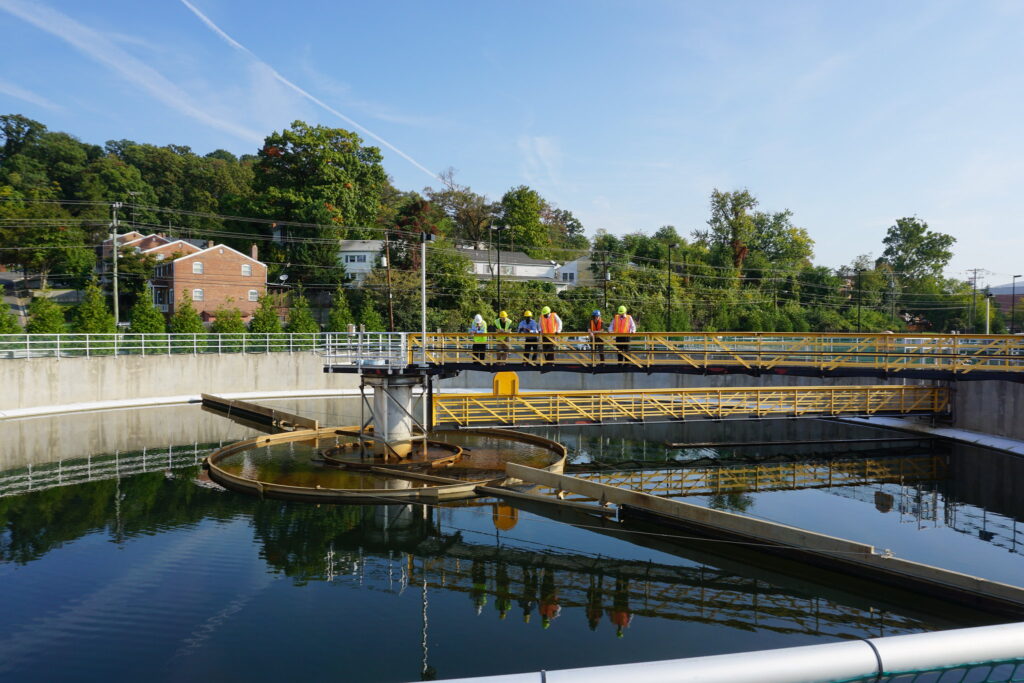While rarely in the spotlight, wastewater treatment facilities play a pivotal role in transforming household sewage into biosolids while safeguarding both public health and the environment. For all homes connected to a sewer system, sewage residuals are processed into biosolids at wastewater treatment plants. While these facilities are not widely discussed in today’s world, they serve as vital infrastructure for communities. To ensure safety and consistency in service, all facilities are governed by EPA and state environmental regulations.
How much sewage sludge does a wastewater treatment plant process each year? The short answer: a crap ton. The average U.S. resident accounts for 37 pounds of biosolids used or disposed of each year. With an estimated 238,643 residents in Arlington County, Virginia, that’s 8.8 million pounds of biosolids a year or 4,440 tons.
What do we do with all those biosolids? The most recent comprehensive analysis on biosolids usage in the US is from a National Biosolids Data Project (NBDP) 2018 report[1] which found 47% of wastewater solids are “placed in landfills or incinerated.”
Sending biosolids to landfills is an increasing topic of discussion, as not all landfills are equipped to process biosolids and some are running out of space. Localities that do not have the equipment to turn wastewater into Class A or B biosolids must find an alternative outlet, which can be costly.
Regardless of the choice in biosolids disposal, wastewater treatment plants are at the heart of every conversation. Mary Strawn is no stranger to these discussions and the role and responsibility of wastewater treatment plants in our communities.
Strawn, who grew up in Arlington County, is the Chief Engineer and project manager for the Arlington Re-Gen program at the Arlington County Water Pollution Control Plant (WPCP).
Arlington County is creating innovative solutions for managing the infinite resource of biosolids resulting from human waste. Strawn has played a unique role, both as an engineer and community liaison for its Re-Gen Program which is part of its Solids Master Plan. In 2015, the plant began collecting data on the condition of the existing facility and their future needs. In 2018, after a thorough review of the plant’s technology, infrastructure, and capacity, the Plan, “recommended options for the modernization of plant facilities (solids treatment), while creating opportunities for sustainability and resource recovery.”
Arlington County’s website outlines the main drivers of the plan were, “1) Replace aging infrastructure–identify immediate and long-term needs. 2) Weigh the possibility of regulatory changes with other criteria to determine treatment options. 3) Make better use of valuable resources. 4) Perform cost and risk analyses. 5) Select long-term solids treatment solution and prepare capital funding program.”
Arlington County is currently designing the plant’s long-term improvements and upgrades, including transitioning to Class A biosolids. The lengthy timeline built into the plan enabled Arlington County WPCP to maintain reasonable utility rates throughout development. Despite the long road, Strawn expects construction to start on the plant next year.
“Class A helps us meet the county’s vision for developing a sustainable outcome for the plant, regardless of regulation changes in Virginia,” explained Strawn. Even in the study phase, the plant was committed to continuing its service as a biosolids processing facility.
Feedback from the community and other key internal and external stakeholders revealed an underlying need for the project to focus on sustainability while minimizing community impact. Knowing the long-term goal of fully transitioning to Class A biosolids, Arlington County WPCP weighed its options. Ultimately, “the potential of dust and odor” from some of the proposed solutions was too high for Arlington County WPCP’s comfort level leading to the selection of utilizing Thermal Hydrolysis Pretreatment and Anaerobic Digestion.
The choice to move to Class A, said Strawn, “provides us with renewable natural gas, as a secondary benefit from these upgrades.” After extensive conversations with the community and key stakeholders, Arlington County WPCP made the decision to upgrade its facility to enable pipeline injection for the gas byproduct, transporting this valuable resource so it can be used, reducing Arlington’s reliance on fossil fuels.
The design process and construction are projected to continue into 2029-30. VBC will keep readers informed on the progress of the plant as the framework in which Strawn and her team navigate the conversations with community members, business partners, government officials, and other stakeholders can serve as a blueprint for broader conversations on the benefits of biosolids.
[1] NBDP chose 2018 as the data year for this nationwide compilation because 2018 is representative of biosolids management in the late 2010s and early 2020s, after sewage sludge incinerator (SSI) regulations and before changes due to PFAS.s.
For answers to many of the public’s biosolids questions can be found on the VBC’s FAQ page.
